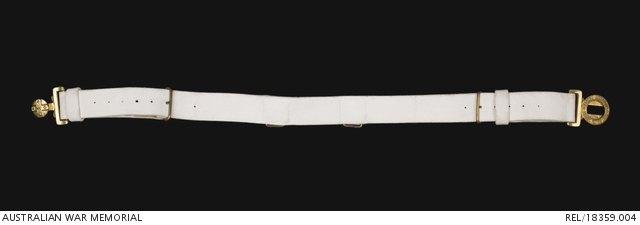| Places | |
|---|---|
| Accession Number | REL/18359.004 |
| Collection type | Heraldry |
| Object type | Uniform |
| Physical description | Brass, Buff leather |
| Maker |
Hobson and Sons |
| Place made | United Kingdom: England, Greater London, London |
| Date made | c 1882-1903 |
| Conflict |
Period 1900-1909 Australian Colonial Forces, 1854-1900 |
Other Ranks 1882 Pattern (Mark III) Valise Equipment waist belt : New South Wales Military Forces

Buff leather waist belt, 1882 Pattern (Mark III) Valise Equipment (described in List of Changes 3994 13 January 1882) with NSW Other Ranks cast brass union locket buckle. The belt is made from one piece of leather (1 6/8 inches wide) with an adjustable billet and brass buckle at each end so the length can be adjusted while keeping the loops in their proper positions for braces when worn. Two retractable brass wire ‘D’ loops lie either side of the centre back of the belt to pass the ends of the braces through when a valise is not worn. The locket (tongue) of the buckle depicts the cross of St George with a lion (indistinctly cast) in the centre and four five-pointed stars at each corner representing the Southern Cross. The circular surround has the words ‘NEW SOUTH WALES MILITARY FORCES’. The maker's name 'HOBSON & SONS LEXINGTON ST LONDON. W' is impressed into the buckle. A running loop lies at each end of the belt in front of the buckle. A retangular leather safe with a rectangular hole is stitched to the proper left running loop. The belt is stamped with two facing broad arrows on the inside indicating that it is the property of the War Department.
The 1882 Pattern Valise Equipment replaced the 1871 pattern. It ws used well into the 1890s and was in service for some years after the introduction of the 1888 Pattern (Slade-Wallace) equipment. The complete equipment consisted of one waist belt, two ammunition pouches, a case and a strap for the Italian water bottle, a pair of braces, two straps for the valise or mess-tin, two straps for the mess-tin or great coat and a valise to hold clothing and personal eqipment. 1882 Pattern equipment can be seen in photographs of NSW soldiers serving with the Sudan Contingent.This waist belt was made by Hobsons and Sons, London, which was established in 1850 near the Woolwich Barracks. The firm acquired premises at Lexington Street around 1880. They supplied equipment under contract to some of the Australian colonies as well as equipment privately purchased by some officers.